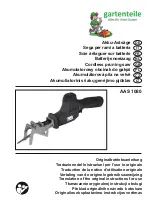
9 ENGLISH
9.
Never force the saw. Push the saw forward at a
speed so that the blade cuts without slowing.
Forcing the saw can cause uneven cuts, loss of
accuracy, and possible kickback.
Lower guard function
1.
Check the lower guard for proper closing
before each use. Do not operate the saw if the
lower guard does not move freely and close
instantly. Never clamp or tie the lower guard
into the open position.
If the saw is accidentally
dropped, the lower guard may be bent. Raise the
lower guard with the retracting handle and make
sure it moves freely and does not touch the blade
or any other part, in all angles and depths of cut.
2.
Check the operation of the lower guard spring.
If the guard and the spring are not operating
properly, they must be serviced before use.
Lower guard may operate sluggishly due to
damaged parts, gummy deposits, or a build-up of
debris.
3.
The lower guard may be retracted manually
only for special cuts such as “plunge cuts”
and “compound cuts”. Raise the lower guard
by the retracting handle and as soon as the
blade enters the material, the lower guard
must be released.
For all other sawing, the lower
guard should operate automatically.
4.
Always observe that the lower guard is cover
-
ing the blade before placing the saw down on
bench or floor.
An unprotected, coasting blade
will cause the saw to walk backwards, cutting
whatever is in its path. Be aware of the time it
takes for the blade to stop after switch is released.
5.
To check lower guard, open lower guard by
hand, then release and watch guard closure.
Also check to see that retracting handle does
not touch tool housing.
Leaving blade exposed
is VERY DANGEROUS and can lead to serious
personal injury.
Additional safety warnings
1.
Use extra caution when cutting damp wood,
pressure treated lumber, or wood containing
knots.
Maintain smooth advancement of tool with-
out decrease in blade speed to avoid overheating
the blade tips.
2.
Do not attempt to remove cut material when
blade is moving. Wait until blade stops before
grasping cut material.
Blades coast after turn off.
3.
Avoid cutting nails. Inspect for and remove all
nails from lumber before cutting.
4.
Place the wider portion of the saw base on
that part of the workpiece which is solidly
supported, not on the section that will fall off
when the cut is made. If the workpiece is short
or small, clamp it down. DO NOT TRY TO HOLD
SHORT PIECES BY HAND!
►
Fig.5
5.
Before setting the tool down after completing a
cut, be sure that the guard has closed and the
blade has come to a complete stop.
6.
Never attempt to saw with the circular saw
held upside down in a vise. This is extremely
dangerous and can lead to serious accidents.
►
Fig.6
7.
Some material contains chemicals which may
be toxic. Take caution to prevent dust inhala
-
tion and skin contact. Follow material supplier
safety data.
8.
Do not stop the blades by lateral pressure on
the saw blade.
9.
Do not use any abrasive wheels.
10.
Only use the saw blade with the diameter that
is marked on the tool or specified in the man
-
ual.
Use of an incorrectly sized blade may affect
the proper guarding of the blade or guard opera-
tion which could result in serious personal injury.
11.
Keep blade sharp and clean.
Gum and wood
pitch hardened on blades slows saw and
increases potential for kickback. Keep blade clean
by first removing it from tool, then cleaning it with
gum and pitch remover, hot water or kerosene.
Never use gasoline.
12.
Wear a dust mask and hearing protection when
use the tool.
13.
Always use the saw blade intended for cutting
the material that you are going to cut.
14.
Only use the saw blades that are marked with
a speed equal or higher than the speed marked
on the tool.
15.
(For European countries only)
Always use the blade which conforms to
EN847-1.
16.
Place the tool and the parts on a flat and stable
surface.
Otherwise the tool or the parts may fall
and cause an injury.
SAVE THESE INSTRUCTIONS.
WARNING:
DO NOT let comfort or familiarity
with product (gained from repeated use) replace
strict adherence to safety rules for the subject
product. MISUSE or failure to follow the safety
rules stated in this instruction manual may cause
serious personal injury.
FUNCTIONAL
DESCRIPTION
CAUTION:
Always be sure that the tool is
switched off and unplugged before adjusting or
checking function on the tool.
Adjusting depth of cut
CAUTION:
After adjusting the depth of cut,
always tighten the lever securely.
Loosen the lever on the depth guide and move the base
up or down. At the desired depth of cut, secure the base
by tightening the lever.
For cleaner, safer cuts, set cut depth so that no more
than one blade tooth projects below workpiece. Using
proper cut depth helps to reduce potential for danger-
ous KICKBACKS which can cause personal injury.
►
Fig.7:
1.
Lever
Summary of Contents for HS6600
Page 2: ...2 Fig 1 Fig 2 Fig 3 Fig 4 Fig 5 Fig 6 1 Fig 7 1 2 Fig 8 ...
Page 5: ...5 1 0 2 Fig 25 1 Fig 26 1 Fig 27 ...
Page 54: ...54 ...
Page 55: ...55 ...










































